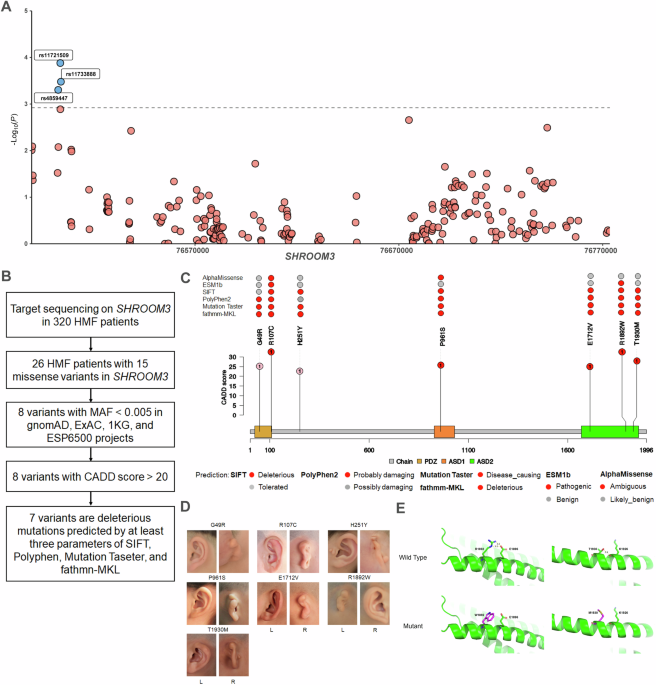
- Select a language for the TTS:
- UK English Female
- UK English Male
- US English Female
- US English Male
- Australian Female
- Australian Male
- Language selected: (auto detect) - EN
Play all audios:
ABSTRACT Hemifacial microsomia (HFM) is a rare congenital disorder that affects facial symmetry, ear development, and other congenital anomalies. However, known causal genes account for only
approximately 6% of patients, indicating the need to discover more pathogenic genes. Association tests demonstrated an association between common variants in _SHROOM3_ and HFM (_P_ =
1.02E-4 for the lead SNP), while gene burden analysis revealed a significant enrichment of rare variants in HFM patients compared to healthy controls (_P_ = 2.78E-5). We then evaluated the
expression patterns of _SHROOM3_ and the consequences of its deleterious variants. Our study identified 7 deleterious variants in _SHROOM3_ among the 320 Chinese HFM patients and 2
deleterious variants in two HFM trios, respectively, suggesting a model of dominant inheritance with incomplete penetrance. These variants were predicted to significantly impact SHROOM3
function. Furthermore, the gene expression pattern of _SHROOM3_ in the pharyngeal arches and the presence of facial abnormalities in gene-edited mice suggest that _SHROOM3_ plays important
roles in facial development. Our findings suggest that _SHROOM3_ is a likely pathogenic gene for HFM. Access through your institution Buy or subscribe This is a preview of subscription
content, access via your institution ACCESS OPTIONS Access through your institution Subscribe to this journal Receive 12 print issues and online access $259.00 per year only $21.58 per issue
Learn more Buy this article * Purchase on SpringerLink * Instant access to full article PDF Buy now Prices may be subject to local taxes which are calculated during checkout ADDITIONAL
ACCESS OPTIONS: * Log in * Learn about institutional subscriptions * Read our FAQs * Contact customer support SIMILAR CONTENT BEING VIEWED BY OTHERS HAPLOINSUFFICIENCY OF _SF3B2_ CAUSES
CRANIOFACIAL MICROSOMIA Article Open access 03 August 2021 _FOXI3_ PATHOGENIC VARIANTS CAUSE ONE FORM OF CRANIOFACIAL MICROSOMIA Article Open access 11 April 2023 _MITF_ VARIANTS CAUSE
NONSYNDROMIC SENSORINEURAL HEARING LOSS WITH AUTOSOMAL RECESSIVE INHERITANCE Article Open access 29 July 2020 DATA AVAILABILITY All data are available upon request. REFERENCES * Luquetti DV,
Cox TC, Lopez-Camelo J, Dutra MdaG, Cunningham ML, Castilla EE. Preferential associated anomalies in 818 cases of microtia in South America. Am J Med Genet A. 2013;161A:1051–7. Article
PubMed Google Scholar * Luquetti DV, Heike CL, Hing AV, Cunningham ML, Cox TC. Microtia: epidemiology and genetics. Am J Med Genet A. 2012;158A:124–39. * Mao K, Borel C, Ansar M, Jolly A,
Makrythanasis P, Froehlich C, et al. FOXI3 pathogenic variants cause one form of craniofacial microsomia. Nat Commun. 2023;14:2026. Article PubMed PubMed Central CAS Google Scholar *
Quiat D, Timberlake AT, Curran JJ, Cunningham ML, McDonough B, Artunduaga MA, et al. Damaging variants in FOXI3 cause microtia and craniofacial microsomia. Genet Med. 2023;25:143–50. Article
PubMed CAS Google Scholar * Timberlake AT, Griffin C, Heike CL, Hing AV, Cunningham ML, Chitayat D, et al. Haploinsufficiency of SF3B2 causes craniofacial microsomia. Nat Commun.
2021;12:4680. Article PubMed PubMed Central CAS Google Scholar * Luquetti DV, Heike CL, Zarante I, Timms AE, Gustafson J, Pachajoa H, et al. MYT1 role in the microtia-craniofacial
microsomia spectrum. Mol Genet Genomic Med. 2020;8:e1401. Article PubMed PubMed Central CAS Google Scholar * Quiat D, Kim SW, Zhang Q, Morton SU, Pereira AC, DePalma SR, et al. An
ancient founder mutation located between ROBO1 and ROBO2 is responsible for increased microtia risk in Amerindigenous populations. Proc Natl Acad Sci USA. 2022;119:e2203928119. Article
PubMed PubMed Central CAS Google Scholar * Zhang YB, Hu J, Zhang J, Zhou X, Li X, Gu C, et al. Genome-wide association study identifies multiple susceptibility loci for craniofacial
microsomia. Nat Commun. 2016;7:10605. Article PubMed PubMed Central CAS Google Scholar * Xu X, Wang B, Jiang Z, Chen Q, Mao K, Shi X, et al. Novel risk factors for craniofacial
microsomia and assessment of their utility in clinic diagnosis. Hum Mol Genet. 2021;30:1045–56. * Ernst S, Liu K, Agarwala S, Moratscheck N, Avci ME, Dalle Nogare D, et al. Shroom3 is
required downstream of FGF signalling to mediate proneuromast assembly in zebrafish. Development. 2012;139:4571–81. Article PubMed CAS Google Scholar * Welter D, MacArthur J, Morales J,
Burdett T, Hall P, Junkins H, et al. The NHGRI GWAS Catalog, a curated resource of SNP-trait associations. Nucleic Acids Res. 2014;42:D1001–6. Article PubMed CAS Google Scholar * Ray D,
Venkataraghavan S, Zhang W, Leslie EJ, Hetmanski JB, Weinberg SM, et al. Pleiotropy method reveals genetic overlap between orofacial clefts at multiple novel loci from GWAS of multi-ethnic
trios. PLoS Genet. 2021;17:e1009584. Article PubMed PubMed Central CAS Google Scholar * Leslie EJ, Carlson JC, Shaffer JR, Butali A, Buxo CJ, Castilla EE, et al. Genome-wide
meta-analyses of nonsyndromic orofacial clefts identify novel associations between FOXE1 and all orofacial clefts, and TP63 and cleft lip with or without cleft palate. Hum Genet.
2017;136:275–86. Article PubMed PubMed Central CAS Google Scholar * Diaz Perez KK, Chung S, Head ST, Epstein MP, Hecht JT, Wehby GL, et al. Rare variants found in multiplex families
with orofacial clefts: does expanding the phenotype make a difference? Am J Med Genet A. 2023;191:2558–70. * Chen Z, Kuang L, Finnell RH, Wang H. Genetic and functional analysis of SHROOM1-4
in a Chinese neural tube defect cohort. Hum Genet. 2018;137:195–202. Article PubMed PubMed Central CAS Google Scholar * Lemay P, Guyot MC, Tremblay E, Dionne-Laporte A, Spiegelman D,
Henrion E, et al. Loss-of-function de novo mutations play an important role in severe human neural tube defects. J Med Genet. 2015;52:493–7. Article PubMed CAS Google Scholar * Xu L,
Yang K, Yin S, Gu Y, Fan Q, Wang Y, et al. Family-based exome sequencing identifies candidate genes related to keratoconus in Chinese families. Front Genet. 2022;13:988620. Article PubMed
PubMed Central CAS Google Scholar * Hildebrand JD, Soriano P. Shroom, a PDZ domain-containing actin-binding protein, is required for neural tube morphogenesis in mice. Cell.
1999;99:485–97. Article PubMed CAS Google Scholar * Cong PK, Bai WY, Li JC, Yang MY, Khederzadeh S, Gai SR, et al. Genomic analyses of 10,376 individuals in the Westlake BioBank for
Chinese (WBBC) pilot project. Nat Commun. 2022;13:2939. Article PubMed PubMed Central CAS Google Scholar * Xu Y, Zhang T, Zhou Q, Hu M, Qi Y, Xue Y, et al. A single-cell transcriptome
atlas profiles early organogenesis in human embryos. Nat Cell Biol. 2023;25:604–15. Article PubMed Google Scholar * Diez-Roux G, Banfi S, Sultan M, Geffers L, Anand S, Rozado D, et al. A
high-resolution anatomical atlas of the transcriptome in the mouse embryo. PLoS Biol. 2011;9:e1000582. Article PubMed PubMed Central CAS Google Scholar * Prokop JW, Yeo NC, Ottmann C,
Chhetri SB, Florus KL, Ross EJ, et al. Characterization of coding/noncoding variants for SHROOM3 in patients with CKD. J Am Soc Nephrol. 2018;29:1525–35. Article PubMed PubMed Central CAS
Google Scholar * Yeo NC, O’Meara CC, Bonomo JA, Veth KN, Tomar R, Flister MJ, et al. Shroom3 contributes to the maintenance of the glomerular filtration barrier integrity. Genome Res.
2015;25:57–65. Article PubMed PubMed Central CAS Google Scholar * Nishimura T, Takeichi M. Shroom3-mediated recruitment of Rho kinases to the apical cell junctions regulates epithelial
and neuroepithelial planar remodeling. Development. 2008;135:1493–502. Article PubMed CAS Google Scholar * Plageman TF Jr, Chung MI, Lou M, Smith AN, Hildebrand JD, Wallingford JB, et
al. Pax6-dependent Shroom3 expression regulates apical constriction during lens placode invagination. Development. 2010;137:405–15. Article PubMed PubMed Central CAS Google Scholar *
Plageman TF Jr, Chauhan BK, Yang C, Jaudon F, Shang X, Zheng Y, et al. A Trio-RhoA-Shroom3 pathway is required for apical constriction and epithelial invagination. Development.
2011;138:5177–88. Article PubMed PubMed Central CAS Google Scholar * Carlson BM. Human embryology and developmental biology. Sixth edition. ed. Elsevier: St. Louis, Missouri, 2019. *
Schlosser G. Induction and specification of cranial placodes. Dev Biol. 2006;294:303–51. Article PubMed CAS Google Scholar * Rossant J, Tam PPL. ScienceDirect. Mouse development:
patterning, morphogenesis, and organogenesis. Academic Press: San Diego, 2002. * Lewandowski JP, Du F, Zhang S, Powell MB, Falkenstein KN, Ji H, et al. Spatiotemporal regulation of GLI
target genes in the mammalian limb bud. Dev Biol. 2015;406:92–103. Article PubMed PubMed Central CAS Google Scholar * Groves AK, Fekete DM. Shaping sound in space: the regulation of
inner ear patterning. Development. 2012;139:245–57. Article PubMed PubMed Central CAS Google Scholar * Lee HJ, Zheng JJ. PDZ domains and their binding partners: structure, specificity,
and modification. Cell Commun Signal. 2010;8:8. Article PubMed PubMed Central Google Scholar * Kim K, Ossipova O, Sokol SY. Neural crest specification by inhibition of the ROCK/Myosin II
pathway. Stem Cells. 2015;33:674–85. Article PubMed CAS Google Scholar * Dietz ML, Bernaciak TM, Vendetti F, Kielec JM, Hildebrand JD. Differential actin-dependent localization
modulates the evolutionarily conserved activity of Shroom family proteins. J Biol Chem. 2006;281:20542–54. Article PubMed CAS Google Scholar Download references ACKNOWLEDGEMENTS We thank
the patients and their guardians for their participation in this research. This work was supported by the National Natural Science Foundation of China (81701930 to B.Q.W.). AUTHOR
INFORMATION Author notes * These authors contributed equally: Qin Li, Bing-Hua Zhang. AUTHORS AND AFFILIATIONS * Department of Stomatology, Eye&ENT Hospital, Fudan University, Shanghai,
200031, China Qin Li, Xiang Zuo & Weiwei Zhang * Shanghai Xuhui District Dental Center, Shanghai, 200032, China Bing-Hua Zhang * Plastic Surgery Hospital, Chinese Academy of Medical
Sciences and Peking Union Medical College, Beijing, 100144, China Qi Chen, Peng Lu & Bingqing Wang * Department of facial plastic and reconstructive surgery, Eye&ENT Hospital, Fudan
University, Shanghai, 200031, China Yaoyao Fu Authors * Qin Li View author publications You can also search for this author inPubMed Google Scholar * Bing-Hua Zhang View author publications
You can also search for this author inPubMed Google Scholar * Qi Chen View author publications You can also search for this author inPubMed Google Scholar * Yaoyao Fu View author
publications You can also search for this author inPubMed Google Scholar * Xiang Zuo View author publications You can also search for this author inPubMed Google Scholar * Peng Lu View
author publications You can also search for this author inPubMed Google Scholar * Weiwei Zhang View author publications You can also search for this author inPubMed Google Scholar * Bingqing
Wang View author publications You can also search for this author inPubMed Google Scholar CONTRIBUTIONS Conceptualization: B.W., W.Z.; Sample collection: W.Z., B.-H.Z., P.L.; Experiments:
Q.L., B.-H.Z., Q.C.; Data analysis: Q.L., B.-H.Z., X.Z.; Writing-original draft: B.W., Q.L., W.Z.; Writing-reviewing and editing: W.Z., B.W. CORRESPONDING AUTHORS Correspondence to Weiwei
Zhang or Bingqing Wang. ETHICS DECLARATIONS COMPETING INTERESTS The authors declare no conflicts of interest. ETHICS All human studies were reviewed and approved by the Ethics Committee of
the Eye & ENT Hospital of Fudan University. An informed consent form was signed by all individuals, and explicit written consent was provided for publication of clinical images.
ADDITIONAL INFORMATION PUBLISHER’S NOTE Springer Nature remains neutral with regard to jurisdictional claims in published maps and institutional affiliations. SUPPLEMENTARY INFORMATION
SUPPLEMENTARY TABLE1 SUPPLEMENTARY FIGURE 1 SUPPLEMENTARY FIGURE 2 SUPPLEMENTARY FIGURE 3 SUPPLEMENTARY FIGURES LEGENDS RIGHTS AND PERMISSIONS Springer Nature or its licensor (e.g. a society
or other partner) holds exclusive rights to this article under a publishing agreement with the author(s) or other rightsholder(s); author self-archiving of the accepted manuscript version
of this article is solely governed by the terms of such publishing agreement and applicable law. Reprints and permissions ABOUT THIS ARTICLE CITE THIS ARTICLE Li, Q., Zhang, BH., Chen, Q.
_et al._ Pathogenic variants in _SHROOM3_ associated with hemifacial microsomia. _J Hum Genet_ 70, 189–194 (2025). https://doi.org/10.1038/s10038-025-01317-1 Download citation * Received: 15
May 2024 * Revised: 14 December 2024 * Accepted: 15 January 2025 * Published: 28 January 2025 * Issue Date: April 2025 * DOI: https://doi.org/10.1038/s10038-025-01317-1 SHARE THIS ARTICLE
Anyone you share the following link with will be able to read this content: Get shareable link Sorry, a shareable link is not currently available for this article. Copy to clipboard Provided
by the Springer Nature SharedIt content-sharing initiative







